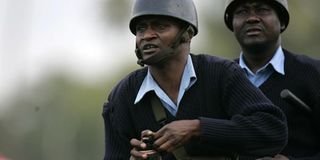Why authorities should bear burden of football hooliganism

A Kenya Police officer pursues rowdy fans during the aborted GOtv Shield Cup semi-final match between AFC Leopards and Sofapaka on October 20, 2014 at City Stadium. PHOTO | CHRIS OMOLLO |
What you need to know:
- Administrators choose to look the other way as thuggery pervades sport
- Hooliganism trend continues to take a well documented path.
- Incredibly these persons have to date somehow managed to evade the jaws of justice.
The Government is facing renewed criticism from the public regarding its role (or lack of it) in curbing the ever increasing hooliganism related cases in local football.
This development arrives days after the country was subjected to horrifying scenes that disrupted a GOtv Shield semi final match involving AFC Leopards and Sofapaka at the City Stadium.
Incidentally, this unfortunate occurrence has reappeared on the week of the fourth anniversary of the Nyayo Stadium stampede, where five youthful supporters were trampled to death at a football stadium in a situation preliminary reports attributed to negligence on the administrators’ part.
In the former incident, thousands of fans, some under age, who had chosen to spend their precious money and time by attending at a local sporting event, within the city on Mashujaa Day, were instead forced to scamper for safety, amidst choking fumes of tear gas fired by the Police to disperse the trouble makers from the facility.
More embarrassing is the fact that scores of fans including match officials, players and journalists who were covering the function were injured during the chaotic incident, whilst property estimated at millions of shillings was vandalised.
This situation reportedly took a turn for the worse because a few ‘fans’ inside the facility were angry with the result of this match and thus, opted to display their frustrations by pelting ‘missiles’ onto the pitch.
Interestingly, this situation is not unique.
Sunday Nation Sport has since established a pattern in which gangs of hooligans have over the past five years not only managed to disrupt sporting activities within and outside local sporting facilities, but also destroyed property, injured innocent spectators and passers-by while also causing traffic snarl ups.
Incredibly these persons have to date somehow managed to evade the jaws of justice.
SIGH OF RELEIF
Earlier this year, football fans and stakeholders alike must have breathed a sigh of relief, when the Cabinet Secretary of Sports, Culture and the Arts Hassan Wario requested for still photos of suspected hooligans during at past matches, with a view of publishing for identification and possible prosecution.
“This would mark the first step in underscoring the seriousness in which hooliganism will be addressed,” a statement signed by Wario, after a meeting that involved other stakeholders of the discipline, read.
Eight months down the line and there remains an eerie silence on how far this project has thus fared. More intriguing is the fact that another meeting recommended by Wario to discuss this thorny subject that was to involve amongst others, the Inspector General of Police, other security agencies alongside football administrators is yet to take place eight months down the line.
“Our body has made several gains in halting acts of hooliganism from our stadiums. But we really have a long way to go as this vice is really slowing down the growth of the game by pushing away both our partners and potential sponsors,” KPL CEO Jack Oguda said.
Still, security agencies stand accused of lacking a strategy of fishing out the few trouble makers from the thousands of fans in the stadium or even dispersing the crowd altogether.
“The only thing the Police know is to lob tear gas canisters into congested areas like terraces, this not only causes panic but leads to everyone rushing around. This can cause a stampede,” AFC Leopards Secretary General George Aladwa says.
Meanwhile hooliganism trend continues to take a well documented path. Based on our research, nine out of ten hooliganism related incidents recorded on the local football in the past five years have been witnessed during games involving either Gor Mahia, AFC Leopards or the national football team.
Curiously, a majority of these incidents have occurred when the aforementioned teams have lost a football match. Worse still are disturbing allegations linking sports administrators and even politicians to some of the chaotic scenes in our stadium.
But until those concerned with the safety of Kenyans stand up and do their job, incidents like such witnessed on Mashujaa Day might transform from sporadic cases to consistent ones.





